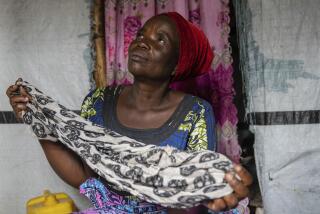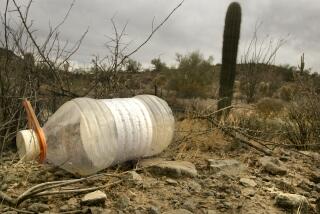To Thousands of Cambodians, Epecially the Children, Camps on Thai Border Maintain the Dust and Misery of a Cruel, Violent Flight From War : Site 2
- Share via
Ten years ago, Vietnamese troops pushed hundreds of thousands of Cambodians across the border into refugee camps in Thailand. They have languished there since, though some of the refugees reportedly have become pawns in a recent, potential new round of battles between Vietnam and Cambodia. Site 2 South, the largest refugee camp on the Thai-Cambodian border, apparently is unaffected by this new tumult. But there already is enough misery at Site 2, reports Los Angeles Times photographer Kari Rene Hall, who spent five weeks there this summer.
They are a generation born without a homeland into a war. Fugitives from a bitter, seemingly endless struggle in their own country, more than 300,000 displaced Cambodians languish in dusty, overcrowded camps on the Thai border like Site 2.
They are ineligible for resettlement in other countries and unable to return to the fields and villages they fled years ago to escape persecution, violence or death.
The world is accustomed to hardened faces of adult refugees on television screens and relief posters. But at Site 2, there is a twist: Nearly half of the 175,000 or so inhabitants are younger than 9 years old. For these children, the drudgery and debilitating loss of hope has become a daily reality, perhaps the only reality they will ever know.
Like their parents, they bear witness to violence on a daily basis--theft, murder, assault and rape. And the problem is growing: The Thai border camps now have one of the highest birthrates in the world.
‘No Innocence’
As a senior camp commander with the U. N. High Commissioner on Refugees concluded, “There is no innocence here.”
Site 2 and other Cambodian refugee camps were created when the Communist Khmer Rouge rebels under Pol Pot swept into Phnom Penh in 1975, overthrew the American-backed government of Lon Nol and evacuated virtually all inhabitants of the cities to the countryside for a radical social restructuring.
In the bloody purge that followed, the rebels carried out a genocide in which an estimated 1 million to 3 million of their countrymen died by execution or because of forced relocation, starvation, exhaustion or disease.
The new government brutally murdered all those suspected of disloyalty or of having been tainted by the influence of the modern world, including doctors, teachers, students and government workers; some people were singled out simply because they wore glasses. Religion and the vestiges of traditional Khmer culture were suppressed.
Thousands who could fled their country and sought refuge in Thailand. In December, 1978, the Vietnamese invaded Cambodia and toppled the Khmer Rouge regime, whose followers retreated to western Cambodia to conduct a guerrilla war against the Vietnamese.
Amid these upheavals, hundreds of thousands more escaped their homeland and fled to the border camps.
The largest of these camps, Site 2, is less than one mile from the Cambodian border inside three square miles ringed by barbed wire. This tightly controlled asylum is the second largest Cambodian community in the world outside of Phnom Penh.
On one level, life in the camp is a godsend compared with life under the Khmer Rouge. International relief agencies under the auspices of U. N. Border Relief Operation continue to supply emergency food rations and provide medical aid to the border encampments.
Discouraging New Arrivals
But Thailand has grown uneasy with the increasing numbers of Cambodian refugees, and the country’s general policy of “humane deterrence” is intended to discourage new arrivals. Those entering Thai territory after 1980 are denied legal status as refugees and are officially classified by the United Nations as displaced persons, ineligible for third-country resettlement. The Thai government has resisted secondary education programs and refused to move the camps farther into Thailand, away from the threat of Vietnamese shelling.
Hopes for a political settlement of the Cambodian conflict have flickered during recent talks among the present Communist regime in Phnom Penh and a three-party guerrilla opposition that includes the Khmer Rouge, the Khmer People’s National Liberation Front, and followers of former Cambodian ruler Prince Norodom Sihanouk.
The Vietnamese have promised to withdraw their troops by 1990, perhaps earlier if there is a political settlement.
If and when the conflict ends, the inhabitants of Site 2 can look forward to repatriation after years of exile. But it will not be easy. After nearly a decade away from their homeland, the survivors are ill-prepared to govern themselves, rebuild their cities or even replant crops.
Small for her age due to a one-dimensional diet, Chan Nak’s body contorts to support her baby sister, Ly, on her hip. When Ly is lulled to sleep by the constant chatter of the nearby black market, Nak gently puts her in a hammock.
Nak’s mother, listless and often ill, rarely ventures from the hut. Blankly staring outside, she begins rocking the hammock while sitting on a bamboo platform that doubles as a bed and table. Nak, sitting below her on the dirt floor of the hut, pounds the dirt with an ax and chases off a chicken that wanders inside.
The young girl takes a can, dips it into the family water jar, and carefully pours it over her head for a shower. With only 18-20 liters of water allotted per person each day for cooking, cleaning and bathing, she must be careful not to waste a drop.
For all nine years of her life, Chan Nak has known no life outside the border camps. She was born as her mother, Ty, made the treacherous journey from her small farming village of Onha in Battambang province through mine fields and around booby-traps on her way to the border.
At the time, Nak’s father, Chan Peov, was 16 and had already joined the KPNLF (Khmer People’s National Liberation Front), anti-communist resistance fighters in the jungle.
Peov, his body covered from chin to foot with the sat tattoos (spiritual protection from bullets) of a seasoned soldier, has finally come in permanently from the battlefield to reunite with his family.
Surviving the Battle
He lost his right leg to a land mine in 1986 during a clash in which his battalion was outnumbered 2-to-1 and out-equipped (light arms versus AK-47s and artillery) against the Vietnamese. The injured Peov was carried to the border camp by his fellow soldiers.
Peov was one of 33 to survive that battle, but he is one of more than 3,000 handicapped (two-thirds are soldier amputees) at Site 2. In a special workshop, he joins his fellow soldiers as they learn to craft and repair their own prosthesis made of wood, leather and old rubber tires.
A technical school for the handicapped will allow Peov to learn typing and watch and radio repair. With only a first-grade education and no practical skills besides military combat, he is beginning to look to the future, no matter how grim.
Nak and Peov spend much of their time together. He gently picks lice from her hair as they visit a relative’s hut to talk to soldiers recently returned from the front line.
Together they walk to get their weekly food rations: 3.5 kilograms of rice per adult, 1.5 kilograms per child, one tin of fish per person, five dried fish for three people, and three logs for two weeks.
Peov promptly sells his family’s rations on the black market and cashes in on a neighborhood gambling game called khrorb kamkeung. If he is lucky, Peov wins enough to buy back some rice, perhaps some vegetables, and even a sweet for Nak. He says he worries that she “never has enough food for her body. She has so little food, she lost her appetite.”
How bad can conditions get at Site 2? A medical report from the American Refugee Committee hospital in the camp describes some of the desperation: “Early in April, two small children were fighting. Their parents, rather than take them home, began to fight among themselves.
“The father of one child hit the other father on the head with an ax several times. That man retaliated, stabbing the first man multiple times with a knife. The man who was stabbed then ran into the other man’s house and axed his wife and children as they slept. Before he died of his stab wounds, he hit a 2 1/2-year-old child in the face several times with an ax.
The child was brought to our hospital with severe facial trauma. This type of incident is becoming more common and raises our concern . . . that the overall psychological well being of this population is deteriorating rapidly.”
From behind the bamboo table at her Khmer People’s Depression Relief Clinic, director Phaly Nuon quietly expounds the wisdom that comes to her from several generations of healers.
One wall has a huge chart of 126 types of bark, roots, branches and leaves for concocting medicines to treat rheumatism, post-natal complications and other illnesses. On the windowsill are jars of potions, some bright red, others orange, yellow and cinnamon. These alcohol-based elixirs are given to patients who suffer from a widespread ailment: weakness.
But there are other medical problems too. The camp handles more than 100 hospitalizations each month from rapes, domestic fights and beatings over the head with axes and firewood. Incidents of violence are up 100% over 1987.
Al Santoli, co-author of a book by the Lawyer’s Committee for Human Rights (a public interest law center in Washington that works to promote international human rights and refugee law and legal procedures) reported in late October that “there have been 20 incidents in the camp of hand grenade explosions in the last few months. It used to be hitting with sticks, then axes were the weapons of choice, now they are using hand grenades. They sell in camp for 20 bacht (about 80 cents).”
Lawless Environment
At Site 2, daily frustration, hopelessness, despair and a lawless environment have triggered an escalation in domestic violence. Fights often start over something as small as stolen water or chickens, but tempers are quick to explode.
“If it (the camp) were a tea kettle, it would be whistling,” observes Wayne Cartwright, a U. N. official.
“(The residents) have many problems because they are poor and are always fighting each other. They want to commit suicide because they despair. They have no hope to leave. Sometimes they miss their family (those killed by Pol Pot) and they do not want to live alone. I cannot take their pain away.”
Medical care at Site 2 is often stretched to the breaking point. The population is almost entirely dependent on outside help, because only 48 of the 367 physicians who were practicing in Cambodia in 1971 survived Pol Pot’s purges.
The camp’s overcrowded quarters, limited water and poor diet have resulted in widespread cases of sepsis, diarrhea, pneumonia, tuberculosis, typhus and tropical diseases such as malaria and dengue fever.
With the growing number of trained medics, however, overall health care is improving. Working side-by-side with Western doctors and nurses, the Khmer medics are getting hands-on training and attending daily classes in practical medicine. They will be able to pass on these techniques to other rural practitioners, if they ever return to Cambodia.
“I am very sad today,” Chhick Ieng Thai says in almost a whisper. “It’s so hard. I live with all these people,” he says with a sweeping gesture to include eight or 10 standing nearby. Sitting on his bamboo platform, he continues, “But I am alone. This is my place. . . . I have nothing. I am poor. I can buy no books to study. That would be something to look forward to.” He fingered a well-worn English grammar book he had borrowed.
“They ask me where I go, why I ride my bike all day. Where do I go? I just ride around and around. I can’t tell them I do not want to stop to think about my life. I have so much pain. I am alone without any parent or sibling to look after me. They were taken to be killed by Khmer Rouge soldiers without doing anything wrong. The problems that happen here remind me to think far away, but I can’t tell it to any other. No one here to help me. I feel so alone.”
The orphanages in the border camp are crowded with 7,000 unaccompanied minors. Many of the oldest were separated from their parents, brothers and sisters by Pol Pot’s soldiers and put into mobile work units and never found their families again. Some, having survived wartime trauma, now realize that they are alone.
Bullet Wound
After seeing his mother, father and a brother killed, for example, 10-year-old Pov Rotana survived a bullet wound to the head. That attack five years ago left him and his 14-year-old brother alone on the border. They now share a hut at the Nong Chan orphanage with 42 other boys.
Two long platform beds stretch the entire length of the hut. Each boy has a spot on the raised platform. Within that 6x3-foot space, each has a bedroll, a few books and school papers, a small cardboard box for their personal belongings and a Boy Scout scarf.
One orphan told of fears that some night, after all the foreign volunteers have left for the day, a truck will pull up and take them back to fight in Cambodia.
Back in Cambodia, many of these children and young men would be especially vulnerable to forced draft into the Khmer People’s National Liberation Front. The anti-communist front, with only a few thousand active resistance fighters, is greatly outnumbered by the Vietnamese forces and is constantly looking for new recruits.
Despite the drudgery of life in the camps, education remains a priority.
Peov walks Nak to and from the small dirt-floored bamboo frame school she attends periodically. As she sits in the front row of bamboo desks with the other girls her age, she carefully forms the Khmer numerals on a chalkboard made from a cardboard box.
Meanwhile, her father and other parents peer curiously in through the lattice openings. Nak’s rudimentary education has already surpassed that of her father, who has never learned to read or write.
For these beleaguered people, schooling is an attempt to hold onto a dying culture. The Pol Pot massacres wiped out virtually all of Cambodia’s educated classes, and many fear for the future of the country if and when the refugees are allowed to return.
“I am worried for the children,” sighs Phaly, the director of the relief clinic. “I think they have no hope. When they grow up, they want to continue to learn. But no good teacher to give them an education. If they do continue to go to school, no hope to do the job they study. No jobs to do.
“They receive everything from (the United Nations). They think rice comes from the back of trucks. They do not know rice is grown from the fields.”
Learning Process
Beyond reading and writing, culture is an important part of the learning process.
Children press closer to the front of a makeshift stage to get a better look at brightly costumed Bassak performers, carrying on one of Cambodia’s rich theatrical traditions. The actors perform with elaborate head-dresses and made-up faces as they swoon, dance and battle in dramas of love, jealousy and bravery.
Thousands crowd into a hot dusty field each Sunday to see the same plays they saw last week and the week before that. Vendors selling soft drinks and snacks do a rousing business. The crowd laughs in unison as youngsters learn folk tales passed down from their parents.
Elsewhere, Cambodian culture is kept alive through drawing classes for children.
Ten- to 12-year-olds at Dong Rec primary school keep small notebooks of drawings they make during class. Lonh Sokha, 10, carefully draws pink and red blossoms in a flower pot next to a bamboo house on stilts. She has never known her home in Cambodia, but knows “it was very beautiful.”
Several others have drawn idyllic scenes of wide blue streams, lush green trees and a sun with long yellow and orange rays setting over the distant pristine mountains.
But Chheng Kodal, 12, draws medics rescuing fallen soldiers and taking them to a border hospital. Another child depicts armed soldiers with machine guns rounding up prisoners at gunpoint.
Most draw the life they know best. Chea Som, 12, sketches himself alone in camp, surrounded by rows and rows of bamboo huts.
Once a father came to teacher Van Yarong and told a disturbing story. While looking through a magazine, his 7-year-old son pointed to a picture and exclaimed, “ Chke (dog)!”
“ ‘It nearly broke my heart,’ ” Yarong says the father told him. “He did not know the water buffalo,” a common sight in Cambodia.
But his son knew nothing of normal everyday life. He had grown up on the border.
More to Read
Sign up for Essential California
The most important California stories and recommendations in your inbox every morning.
You may occasionally receive promotional content from the Los Angeles Times.










